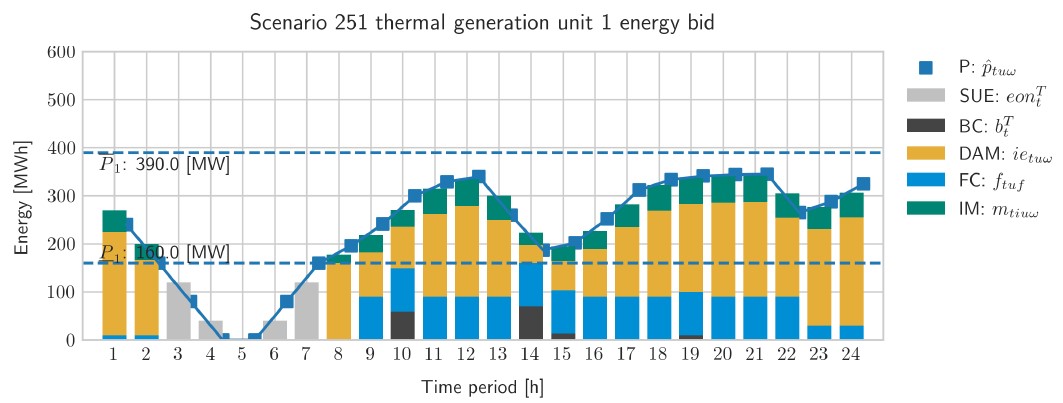electricity market
Optimal Participation of Energy Communities in Electricity Markets under Uncertainty. A Multi-Stage Stochastic Programming Approach
Thu, 10/24/2024 - 11:48 — admin| Publication Type | Conference Paper |
| Year of Publication | 2024 |
| Authors | Albert Solà Vilalta, Marlyn Cuadrado, Ignasi Mañé, F.-Javier Heredia |
| Conference Name | ISMP2024, 25th International Symposium on Mathematical Programming |
| Conference Date | 21-26/07/2024 |
| Conference Location | Montréal, Canada. |
| Type of Work | Invited presentation |
| Key Words | energy communities; electricity markets; demand flexibility; prosumers; mathematical optimization; stochastic programming; research |
| Abstract | An energy community is a legal figure, recently coined by the European Union, that creates a framework to encourage active participation of citizens and local entities in the energy transition to net-zero. In this work, we study the optimal participation of energy communities in day-ahead, reserve, and intraday electricity markets. where energy communities cannot meet their internal demand, and periods where they generate excess electricity. This is because the electricity they generate often comes from variable renewable resources like solar and wind. Electricity market participation is a natural way to ensure they meet their internal demand at all times, and, simultaneously, make the most of the excess electricity. We propose a multi-stage stochastic programming model that captures variable renewable and electricity price uncertainty. The multi-stage aspect models the di¿erent times at which variable renewable generation is considered to be known and electricity prices from di¿erent markets are revealed. This results in a very large scenario tree with 34 stages, and hence a very large optimization problem. Scenario reduction techniques are applied to make the problem tractable. Case studies with real data are discussed, considering di¿erent energy community configurations, to analyse proposed regulatory frameworks in Europe. The added value of considering stochasticity in this problem is also analysed. The motivation to do so is that there are time periods |
| URL | Click Here |
| Export | Tagged XML BibTex |
Optimal Participation of Energy Communities in Electricity Markets under Uncertainty. A Multi-Stage Stochastic Programming Approach
Thu, 10/24/2024 - 11:36 — admin| Publication Type | Conference Paper |
| Year of Publication | 2024 |
| Authors | Albert Solà Vilalta, F.-Javier Heredia |
| Conference Name | EURO24, 33rd European Conference on Operational Research |
| Conference Date | 30/06-3/07/2024 |
| Conference Location | Technical University of Denmark (DTU), Copenhagen, Denmark. |
| Type of Work | Contributed presentation |
| Key Words | electricity markets; energy communities, mathematical optimization; stochastic programming; research |
| Abstract | An energy community is a legal figure, recently coined by the European Union, that creates a framework to encourage active participation of citizens and local entities in the energy transition to net-zero. In this work, we study the optimal participation of energy communities in day-ahead, reserve, and intraday electricity markets. The motivation to do so is that there are time periods where energy communities cannot meet their internal demand, and periods where they generate excess electricity. This is because most of the electricity they generate comes from variable renewable resources like solar and wind. Electricity market participation is a natural way to ensure they meet their internal demand at all times, and, simultaneously, make the most of the excess electricity. We propose a multi-stage stochastic programming model that captures variable renewable and electricity price uncertainty. The multi-stage aspect models the di erent times at which variable renewable generation is considered to be known and electricity prices from di erent markets are revealed. This results in a very large scenario tree with 34 stages, and hence a very large optimization problem. Scenario reduction techniques are applied to make the problem tractable. Case studies with real data are discussed, considering di erent energy community configurations, to analyse proposed regulatory frameworks in Europe. The added value of considering stochasticity in this problem is also analysed. |
| URL | Click Here |
| Export | Tagged XML BibTex |
Unified multi-market participation of energy communities in energy markets (OptiREC)
Tue, 01/17/2023 - 20:34 — admin| Publication Type | Funded research projects |
| Year of Publication | 2022 |
| Authors | F.-Javier Heredia; Albert Solà Vilalta; Marlyn Dayana Cuadrado Guevara |
| Type of participation | Leader |
| Duration | 01/23-12/24 |
| Call | PROYECTOS DE TRANSICIÓN ECOLÓGICA Y TRANSICIÓN DIGITAL 2021 |
| Funding organization | MINISTERIO DE CIENCIA E INNOVACIÓN |
| Partners | IREC, Universitat de Girona, Universidad Comillas. |
| Full time researchers | 2,5 |
| Budget | 149.500€ |
| Project code | TED2021-131365B-C44 |
| Key Words | research; TED2021-131365B-C44; energy communities; electricity markets; bilevel stochastic programming |
| Abstract | The general purpose of this subproject is to study the participation of energy communities in the multimarket structure of the wholesale electricity market in order to develop mathematical models and computational tools for the optimal bid to wholesale markets. From the point of view of the wholesale electricity market, all the complexity of the inner structure of energy communities (dispatchable and nondispatchable generation, storage, demand,) can be conceptually understood as a single virtual programming unit ( a Community Virtual Programming Unit, CVPU) that participate in the wholesale electricity multimarket structure (spot and ancillary-services markets). The final goal of this project is to develop a multi-stage stochastic-programming model for the Multimarket Optimal Bid of Energy Communities (MOBEC) problem that will be validated with real data from the Iberian Electricity Market (MIBEL). Conceptually speaking, energy communities are a complex energy system comprising dispatchable and non-dispatchable generation, energy storage systems and an own demand, that participate in the wholesale electricity market. Based on the experience of previous studies the extension of stochastic programming models to energy communities is a fairly natural and a sounded research methodology. First, the participation of energy communities in spot markets will be analysed. Spot markets (day and intraday) are the most important one in terms of the amount of energy traded. A CVPU will be defined allowing the energy community to submit bids to the single day ahead and to the multiple intraday markets, according to the MIBEL rules. Second, the participation of energy communities in ancillary services markets will be studied. Dispatchable generation units (thermal) together with storage devices and demand flexibility provide the energy community with reserve capabilities that can be bid to the secondary reserve market. The reserve of the CVPU will be defined, formulated and integrated in the (MOBEC) optimization model. The resulting model will be implemented and validated with real data from the real energy communities and the MIBEL. Multi-stage stochastic programming optimal bid models have been successfully developed so far for generation+storage units and will be extended in this project and adapted to the specific features of an energy community through a CVPU that participates in the wholesale electricity market as a single programming unit. |
| Export | Tagged XML BibTex |
Presentation at the EURO 2022 conference in Finland.
Fri, 07/08/2022 - 12:10 — admin
Multistage stochastic programming for the optimal bid of a wind-thermal power production pool with battery storage.
Fri, 07/08/2022 - 11:26 — admin| Publication Type | Conference Paper |
| Year of Publication | 2022 |
| Authors | F.-Javier Heredia; Ignasi Mañé; Marlyn Dayana Cuadrado Guevara |
| Conference Name | EURO 2022 |
| Conference Date | 03-06/07/2022 |
| Conference Location | Espoo, Finland. |
| Type of Work | Invited presentation |
| ISBN Number | 978-951-95254-1-9 |
| Key Words | research; multistage stochastic programming; virtual power plants; unit commitment |
| Abstract | In this study we present a multistage stochastic programming model to find the joint optimal bid to electricity markets of a pool of dispatchable (thermal) and non-dispatchable (wind) production units with battery storage facilities. The assumption is that these programming units are operated by the same utility that, previous to the market clearing, has to dispatch some bilateral contracts with the joint production of the production pool. The multistage model mimics the multimarket bidding process in the Iberian Electricity Market (MIBEL). First, the utility has to decide how to cover the energy of the bilateral contracts with the available units. Second, the production capacity of each unit, not allocated to the bilateral contracts, must be offered to the seven consecutives spot markets (day-ahead and six intraday markets) plus the secondary reserve market (the most relevant ancillary services market). The stochasticity of the electricity clearing prices and the hourly generation of the wind-power units is considered. The stochastic process associated to this multistage decision-making process is modelled through multistage scenario trees with thirty-four stages that are built from forecasting models based on real data of the Iberian Electricity Market. The numerical results show the advantage of the joint operation of the pool of production units with an increase of the overall expected profits, mainly due to a strong reduction of the operational costs. |
| URL | Click Here |
| Export | Tagged XML BibTex |
Article sobre la crisi dels preus de l'electricitat al blog 5centims.cat
Tue, 01/18/2022 - 13:15 — admin

L'encariment dels costos de producció de l'energia elèctrica justifiquen realment el període de preus sense control de l'electricitat que estem observant durant els darrers mesos de 2021? I quin és el paper que juguen les regles de mercat i les centrals hidroelèctriques en aquesta tendència alcista dels preus? Intentem respondre a aquestes preguntes a l'article Costos de producció: causa o excusa de la crisi de preus de l'electricitat? publicat a 5centims.cat, blog de debat econòmic creat el 2021 al si de la Societat Catalana d'Economia (SCE).
Multistage stochastic bid model for a wind-thermal power producer
Thu, 12/30/2021 - 13:20 — admin| Publication Type | Tesis de Grau i Màster // BSc and MSc Thesis |
| Year of Publication | 2021 |
| Authors | Ignasi Mañé Bosch |
| Director | F-Javier Heredia |
| Tipus de tesi | MSc Thesis |
| Titulació | Master in Statistics and Operations Reseafrch |
| Centre | Facultat de matemàtiques i Estadística |
| Data defensa | 18/10/2021 |
| Nota // mark | 9.5 |
| Key Words | teaching; electricity markets; multistage stochastic programming |
| Abstract | For many political and economic reasons, over the last decades, electricity markets in developed countries have been liberalised. Markets regulated by governments in which prices were set by the competent authority are now the exception. In this new setting, electricity agents, both consumers and producers, compete to maximise their pro tability in a series of auctions designed to efficiently match supply and demand. Many energy producers manage together wind and thermal generation units to meet their contractual obligations such as bilateral contracts, as well as bid on the electric market to sell their production capacity. This master thesis explore different multi-stage stochastic programming models for generation companies to nd optimal bid functions in electric spot markets. The explored models not only capture the uncertainty of electric prices of different markets and financial products, but also couples together wind and thermal generation units, offering producers that combine both technologies a more suitable approach to nd their best possible bidding strategy among the space of possible actions. |
| URL | Click Here |
| Export | Tagged XML BibTex |
Master Thesis on electricity markets.
Wed, 12/01/2021 - 13:35 — adminOn November 2021 Mr. Ignasi Mañé presented the MsC thesis dissertation Multistage stochastic bid model for a wind-thermal power producer to opt for the master's degree in Statistics and Operations Research (UPC-UB), advised by prof. F.-Javier Heredia. This master thesis explores different multi-stage stochastic programming models for generation companies to find optimal bid functions in electric spot markets capturing the uncertainty of electric prices of different markets and financial products, and coupling together wind and thermal generation unit
Participation in the 31st European Conference on Operational Research.
Tue, 07/13/2021 - 11:24 — admin
Multistage Scenario Trees Generation for Electricity Markets Optimization
Tue, 07/13/2021 - 10:51 — admin| Publication Type | Conference Paper |
| Year of Publication | 2021 |
| Authors | Marlyn Dayana Cuadrado Guevara; F.-Javier Heredia |
| Conference Name | 31st European Conference on Operational Research. |
| Conference Date | 11-14/07/2021 |
| Conference Location | Athens |
| Type of Work | Invited presentation |
| ISBN Number | ISBN 978-618-85079-1-3 |
| Key Words | research; multistage stochastich programming; virtual power plants; electricity markets; scenarios tree generation |
| Abstract | The presence of renewables in electricity markets optimization have generated a high level of uncertainty in the data, which has led to a need for applying stochastic optimization to model this kind of problems. In this work, we apply Multistage Stochastic Programming (MSP) using scenario trees to represent energy prices and wind power generation. We developed a methodology of two phases where, in the first phase, a procedure to predict the next day for each random parameter of the MSP models is used, and, in the second phase, a set of scenario trees are built through Forward Tree Construction Algorithm (FTCA) and a modified Dynamic Tree Generation with a Flexible Bushiness Algorithm (DTGFBA). This methodology was used to generate scenario trees for the Multistage Stochastic Wind Battery Virtual Power Plant model (MSWBVPP model), which were based on MIBEL prices and wind power generation of a real wind farm in Spain. In addition, we solved three di erent case studies corresponding to three di erent hypotheses on the virtual power plant’s participation in electricity markets. Finally, we study the relative performance of the FTCA and DTGFBA scenario trees, analysing the value of the stochastic solution through the Forecasted Value of the Stochastic Solution (FVSS) and the classical VSS for the 366 daily instances of the MSWBVPP problem spanning a complete year. |
| URL | Click Here |
| Export | Tagged XML BibTex |
